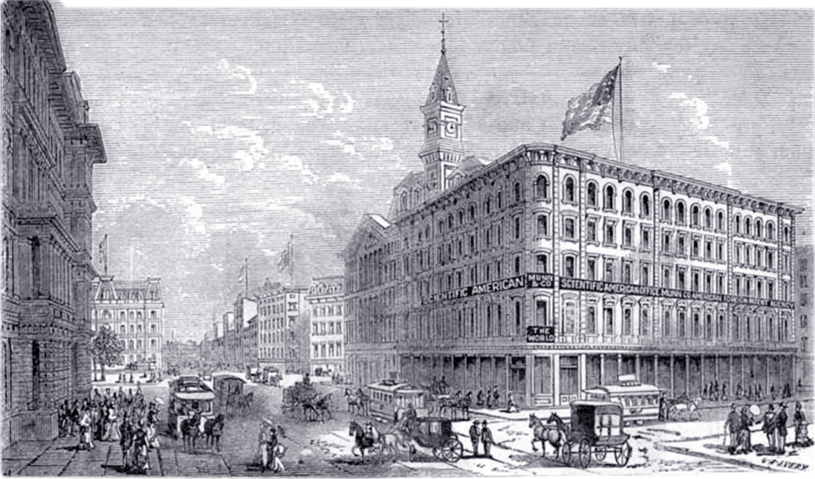
Park Row in 19th Century
Park Row, part of the old Post-Road to Boston, from present-day intersection with Broadway, at Ann Street, to Chatham Square, was officially named Chatham Street in 1774, after the Earl of Chatham. It became officially Park Row in 1886.
In the first half of the 19th century, despite its official name, the section of Chatham Street, bordering City Hall Park, was commonly called Park Street, Park Row. The Cornelius Tiebout's Plan, 1792 indicated the initial section to Frankfort Street as Chatham Row and the northern section as Chatham Street. In the Longworth's Map, 1817, the initial section is "Park". However, the map by Thomas H. Poppleton, city surveyor, issued in 1817, adopted the official name for the entire street.
More: City Hall Park in the 19th Century ►
The new City Hall attracted many publishing industry headquarters to the area. Broadway, on the west side, had office buildings with many stores. The publishing industry preferred the east side of the Park, from the New York Herald, which moved in 1867 to the corner of Ann Street, to the New Yorker Staats-Zeitung, which moved in 1873, from 17 Chatham Street to the a new building, northeast of the Park. After de demolition of the Brick Church at Beekman Street, in 1857, and the construction on the New York Times Building, completed in 1858 at 41 Park Row, the Printing House Square was formed (the area was officially named City Hall Square in 1848).
Among the publishers in the area, there were The World, Scientific American, Baker & Godwin, New York Times, Tribune, Sunday Times, New Yorker Staats-Zeitung, the New York Observer, Evening Mail, The Day Book / Weekly Day Book (1848–1879), Currier & Ives, Army & Navy Journal, The Albion, The Sun, The Sentinel and Freeman's Journal (in Tryon Row Buildings), American Tract Society and others. In the late 19th century, Park Row was also known as Newspaper Row. There were also other publishers around City Hall Park, such as The Technical Press, The New York Herald, the New-York Evening Post, the New York Evening Mail and others. In the late 19th century and early 20th century, many publishing industry headquarters moved to other parts of the City.
The old five-story Park Building, at 37 Park Row, was completed in 1857, sharing the site of the Old Brick Church with the NY Times Building. Later it became known as World Building (the old one). It housed some publishing industry headquarters, including The World, Scientific American and the New York Observer, founded in 1823. The building was burned down in 1882 and a new 11-story Potter Building was erected from 1883 to 1886, today a New York City landmark.
In 1854, 27-year-old schoolteacher Elizabeth Jennings Graham boarded a streetcar, at the corner of Pearl Street and Chatham Street, that did not accept African Americans as passengers. She refused to leave and was forcibly removed by the police. She wrote a letter telling her story, which was read at a meeting held in her family’s church. Those present at the meeting voted to form a committee to take her story to legal authorities. In 1855, the court ruled in her favor. In his charge to the jury, Brooklyn Circuit Court Judge William Rockwell declared: "Colored persons if sober, well-behaved and free from disease, had the same rights as others and could neither be excluded by any rules of the company, nor by force or violence". Jennings was represented by a 24-year-old lawyer, Chester A. Arthur. He later became the 21st President of the United States. In 2007, New York City co-named a block of Park Row "Elizabeth Jennings Place".
The old five-story City Hall Post Office building was constructed between 1869 and 1880, at the southern part of the Park. It was demolished in 1939.
In 1883, the Park Row Terminal, for the Brooklyn Bridge, was opened.
Some of the early skyscrapers in New York City were built in Park Row or close to it, starting with the Tribune Building, which opened in 1875. In 1889, The NY Times Building was reconstructed to became a 13-story building. Then the World Building, completed in 1890, was the tallest building in New York City until 1894, when it was surpassed by the Manhattan Life Building. The American Tract Society skyscraper at 150 Nassau Street, adjacent to Printing House Square, was completed in 1895. In 1899, the 31-story Park Row Building (15 Park Row) was completed between Beekman and Ann streets. It was the tallest building in Manhattan at the end of the 19th century.

◄ Park Row
Park Row, looking north from the old Post Office (left). Illustration published in the Scientific American (February 11, 1882), whose headquarters was in the Park Building, on the right, adjoining the NY Times Building. This building was destroyed by fire on January 31 of the same year.
Below, view from the opposite side.

|
Copyright © Geographic Guide - Old NYC. Historic Places. |
Park Row in 19th Century